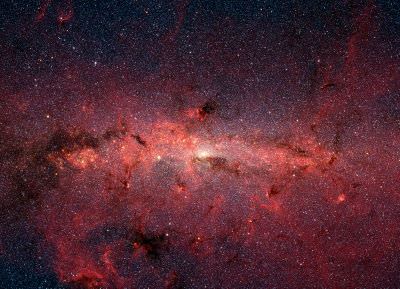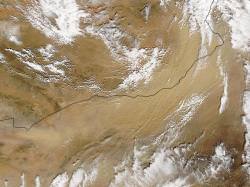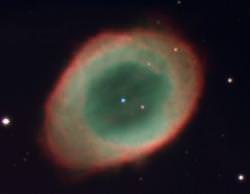 It can be said that humans have a bit of a short term view of things. We're concerned about the end of summer, the next school year, and maybe even retirement. But these are just a blink of an eye in cosmic terms. Let's really think big, stare forward in time, and think about what the future holds for the Universe. Look forward millions, trillions, and even 10100 years into the future. Let's consider the end of everything.
It can be said that humans have a bit of a short term view of things. We're concerned about the end of summer, the next school year, and maybe even retirement. But these are just a blink of an eye in cosmic terms. Let's really think big, stare forward in time, and think about what the future holds for the Universe. Look forward millions, trillions, and even 10100 years into the future. Let's consider the end of everything.
End of Humanity - 10,000 years
Modern humans originated in Africa about 200,000 years ago. Since then, we've gone on to inhabit every single corner of the globe. But this is just temporary. The vast majority of every species that has ever lived on Earth is now extinct. To think that humans can avoid the fate of every other creature is arrogant. Like all life on Earth, our time is limited. How long will we last?
There are many natural and man made disasters that could wipe us out. From an asteroid strike to worldwide pandemic; global warming to a nearby supernova detonation - there are many ways we could go. Perhaps we'll wrap it up in a mass extinction event, such as the one that killed the dinosaurs 65 million years ago, or "the Great Dying", 251 million years ago that killed 70% of land species and 96% of all marine species.
Perhaps another species (intelligent cockroaches, rats) will evolve, and out compete with us in our niche. Or maybe we'll engineer our robotic replacements.
But a species can last tens or even hundreds of millions of years. So how can we predict when our number will be up?
There's no way to know, but there's a calculation that can help. It's called the Doomsday Argument, developed in 1983 by astrophysicist Brandon Carter. According to Carter, if you assume that half of the humans who will ever live have already been born, you get approximately 60 billion people. If you assume that another 60 billion are yet to be born, our high population levels only give us another 9,000 years or so. Or more precisely, there's a 95% chance that humanity will have ended by the year 11,000.
There are other calculations, but they give similar amounts, ranging from a few thousand to a few million years.
That's a long time, but not long enough to appreciate the future the Universe has in store for itself.
End of Life - 500 million years - 5 billion years
We thank the Sun for giving us energy. Without it, there'd be no life on Earth. It's ironic, then, that the Sun will eventually kill all life on Earth.
That's because the Sun is slowly heating up.
One of the most fascinating books about this topic is The Life and Death of Planet Earth by Peter Ward and Donald Brownlee. In their book, they chronicle how Sun's energy output is slowly increasing. In as soon as 500 million years, temperatures on Earth will rise to the point that most of the world will be a desert. The largest creatures won't be able to survive anywhere but the relatively cooler poles.
Over the course of the next few billion years, evolution will seem to go reverse. The largest organisms and least heat tolerant animals will die out, leaving hardy insects and bacteria. Finally, it'll be so hot on the surface of the Earth that the oceans will boil away. There'll be no place to hide from the terrible temperatures. Only the organisms that live deep underground will survive, as they have already for billions of years.

End of the Earth - 7.5 billion years
As mentioned above, we exist because of the Sun's good graces. But as our star nears the end of its lifetime, it'll take our planet out as it goes; one way or another.
In approximately 5 billion years from now, the Sun will begin the final stage of its life, consuming the last of its hydrogen fuel supply. At that point, gravity will force the Sun to collapse, and only a small amount of hydrogen will remain in a shell wrapped around the star's core. It will then expand into a red giant star, consuming each of the inner planets: first Mercury, then Venus, and finally encompassing even the orbit of Earth.
There is a controversy about whether or not a red giant Sun will actually burn up the Earth. In some scenarios, the change in the Sun's density as it expands causes the Earth to spiral out away from the Sun, keeping out of reach. In another scenario, the Sun's outer envelope will enclose the Earth. The additional friction will slow the Earth down, causing it to spiral down into the Sun.
Whatever the outcome, the Earth will be scorched to a cinder, and effectively destroyed, 5 billion years from now.
End of the Sun - 7.5 billion - 1 trillion years
When the Sun becomes a red giant, that's only the beginning of the end. With the end of its hydrogen, the Sun will have switched to fusing helium, then carbon, and finally oxygen. At that point, our Sun will lack the gravity to continue the fusion process. It will shut down, and shed its outside layers to form a planetary nebula, such as the ring nebula we can see in the night sky. It'll then settle down to live out the rest of its days as a white dwarf.
It will still retain most of its mass, but have a size no larger than the Earth's diameter. Once yellow-hot with the heat of fusion, the Sun will slowly cool down over time. Eventually, its temperature will match the background temperature of the Universe and it will become a cold black dwarf - an inert chunk of matter floating in the darkness of space.
Even the oldest white dwarfs still radiate at several thousand degrees Kelvin, so the Universe hasn't been around long enough for black dwarfs to exist.. yet. But give the Sun another 1 trillion years or so, and it should finally become a cold black dwarf.

End of the Solar System
Even though the Sun will have burned out billions of years from now, the planets that weren't consumed will remain. Perhaps even Earth will join that group. Certainly Jupiter, Saturn, the rest of the outer planets and the Kuiper belt objects will remain orbiting for eons.
A recently discovery, published in the journal Science, reported that astronomers had discovered a disk of rapidly rotating metallic material orbiting a white dwarf. Researchers built a simulation where they put hypothetical planets in orbit around a dying star, and found that the star's death wreaked havoc on the stability of a star system. Changes in the mass of a star causes planets to collide, and rearrange their orbits. Some spiral into their star, while others are ejected into interstellar space.
Once all these new gravitational interactions are worked out, all that might remain of our solar system is the white dwarf remnant of our Sun and the rapidly rotating disk of planetary wreckage surrounding it. Everything else will be lost to interstellar space.

End of Cosmology - 3 Trillion Years from Now
The Universe acts as a natural time machine. Since light moves at the speed of, well, light, we can look at distant objects and see them how they looked in the past. Look to the very ends of the visible Universe, and you see light that was emitted billions of years ago, shortly after the Big Bang.
It's handy, but there's a problem. That mysterious dark energy force, which is accelerating the expansion of the Universe is making the most distant galaxies move faster and faster away from us. Eventually, they will cross an event horizon and appear to be moving away from us faster than the speed of light. At this point, any light emitted by the galaxy will cease to reach us. Any galaxy that crosses this horizon will fade away from view, until its last photon reaches us. All galaxies will disappear from view forever.
According to a new research paper by Lawrence M. Krauss and Robert J. Scherrer, future astronomers living 3 trillion years from now will only see our own galaxy when they look into the night sky.
This accelerating expansion has another consequence as well. The cosmic microwave background radiation, which astronomers used to discover evidence of the Big Bang will have faded away too. Not only that, but the abundance of chemicals, which precisely match the amounts theorized for the Big Bang will be hidden by subsequent generations of stars.
And so, 3 trillion years from now, there won't be any trace of the Big Bang. No clues for future cosmologists to recognize that the Universe we live in started from a single point, and has been expanding ever since. The Universe will seem static and unchanging.

End of the Milky Way
Galaxies collide. All you have to do is look out into space with a telescope and see the fate that awaits our galaxy. In all directions we can see the interactions between the gravity of various galaxies. At first the encounters are violent; galaxies tear at each other, stripping off material, and generating huge swaths of star formation. The dormant supermassive black holes at their centres spring to live and become active galactic nuclei, gobbling up the newly delivered material.
Our future merger partner is barreling towards us right now: Andromeda. In approximately 2 billion years from now, our two galaxies will collide, and then pull apart. Then they'll collide again and again until they settle down into a new, larger galaxy: Milkomedia. The twin supermassive black holes will orbit one another, and eventually merge together into an even more massive black hole.
Our position in the galaxy will change; we'll probably be pushed out to the outer reaches of the galaxy's halo - at least 100,000 light years from the centre. Since the Sun will still have billions of years left, some future form of life on Earth might be around to watch these events unfold.
The merger process will be complete approximately 7 billion years from now.
That's not the end of the galaxy, though. It will still be an island in space, with stars orbiting a central core. Over a long period of time, though, estimated to be between 1019 1020 years. The galaxy will erode, with all the stars escaping into intergalactic space.

End of Stars - 100 trillion years from now
We can look out into the Milky Way and see stars forming all around us. There is still enough remaining gas and dust in the Milky Way to create whole new generations of stars. But when we look at other galaxies, we can see older, elliptical galaxies which have already used up their free gas and dust. Instead of the bright, hot stars we see in star forming regions, these aging red galaxies are cooling down.
One day there won't be newly forming stars at all. And then one day, the last star will use up the last of its hydrogen fuel, become a red giant and then fade away to a white dwarf. Even the dimmest stars, the cool red dwarfs will use up their fuel - although, it might taken another 10 trillion years or so. They too will turn into black dwarfs.
And so, in about 100 trillion years from now, every star in the Universe, large and small, will be a black dwarf. An inert chunk of matter with the mass of a star, but at the background temperature of the Universe.

The End of Regular Matter - 1030 years
So now we have a Universe with no stars, only cold black dwarfs. There will also be neutron stars and black holes left over from the time where there were stars in the Universe. The Universe will be completely dark.
A future observer might notice the occasional flash, when some object interacts with a black hole. Its matter will spread out into an accretion disk around the black hole. And for a brief period, it will flare up, emitting radiation. But then it too will be added to the mass of the black hole. And everything will go dark again.
Chunks of matter and binary black dwarfs will merge together creating new black holes, and these black holes will be consumed by even larger black holes. It might be that in the far future, all matter will exist in a few, truly massive black holes.
But even if matter escapes this fate, it's doomed eventually. Some theories of physics predict that protons are unstable over long periods of time. They just can't last. Any matter that wasn't consumed by a black hole will start to decay. The protons will turn into radiation, leaving a fine mist of electrons, positrons, neutrinos and radiation to spread out into space.
Theorists anticipate that all protons in the Universe will decay over the course of 1030 years.

End of Black Holes - 10100 Years
Black holes were thought to be one-way streets. Matter goes in, but it doesn't come out. But famed astrophysicist Stephen Hawking turned that concept on its head with his theory that black holes can evaporate. It's not much, and it's not fast, but black holes release a tiny amount of radiation back into space.
As it releases this radiation, the black hole actually loses mass, finally evaporating away entirely. The amount of radiation increases as the black hole loses mass. It's actually possible that it could generate a final burst of X-rays and gamma rays as it disappears completely. Future observers (who survived their protons decaying) might see the occasional flash in an otherwise dark universe.
And then in about 10100 years, the last black hole will be gone. All that remains is the radiation emitted.

The End of Everything - 10100 years and beyond
When the last black hole evaporates, all that will remain in the Universe are photons of radiation, and elementary particles that escaped capture by black holes. The temperature of the entire Universe will reach a final temperature just above absolute zero.
Dark energy may play some future role, continuing the expansion of the Universe, accelerating each of these elementary particles and photons away from each other until they're effectively cut off from one another. No future gravity will bring them together again.
Perhaps there will be another Big Bang someday. Perhaps the Universe is cyclical and the whole process will start up again.
Perhaps it won't, and this bleak future of a cold, dead Universe is all that awaits us. It's not happy, but it's awe inspiring to consider the long future ahead, and helps us appreciate the vibrant age we live in today.





No comments:
Post a Comment